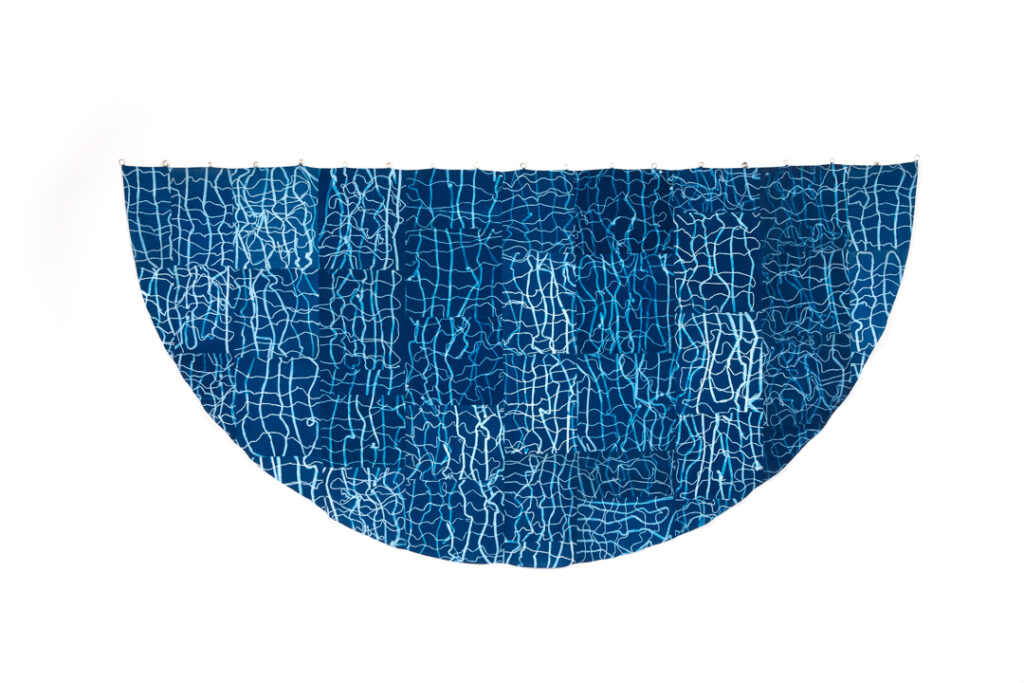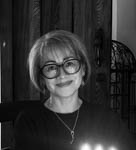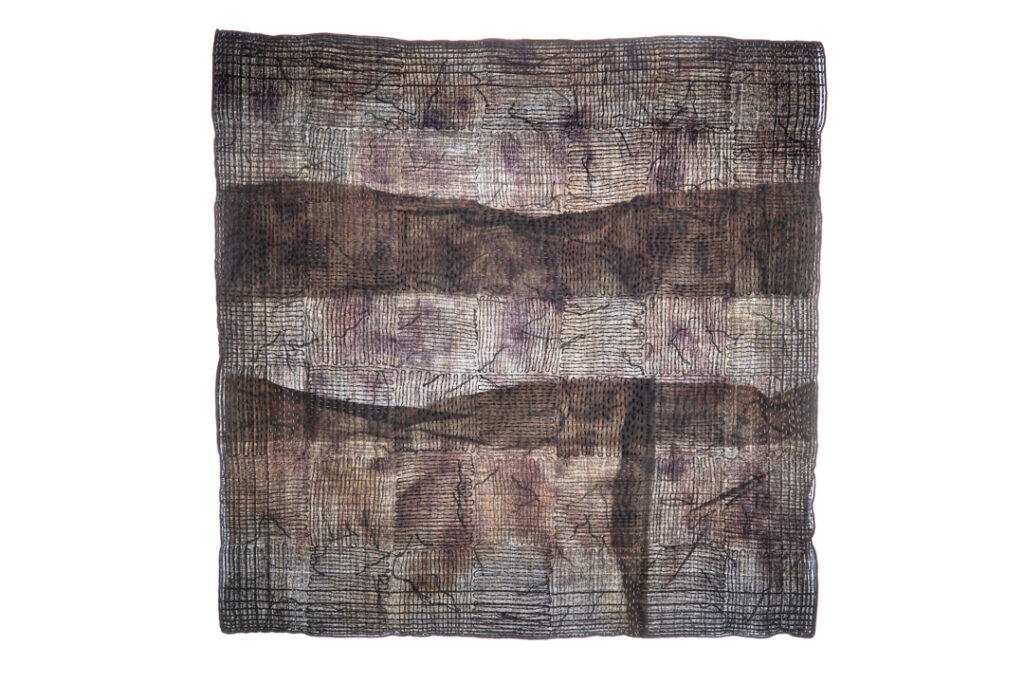
Michele Elliot, cloak (das hajar tender stranger) 2024, cyanotype on cotton sheet, collected silver rings,150x300cm. Photo: Frances Mocnik
Lisa Pang reviews an exhibition of textile works that reflect the threads of life.
Here, held closely, within this humblest of cloths, his hanky. Unfolded with care, a handful of chillies comes spilling out. This spilling of bright fruits as a spilling of stories that unravel at once deeply personal and universally shared experience is allegorical of Michele Elliot’s practice and is at the heart of her solo exhibition what is held, is here at Wollongong Art Gallery. The heartfelt quality of each work lingers long after it is seen and its resonance is in the way it gently takes us in. Every work has a story. Mostly, the story begins with some small detail, like this memory of a habit of the artist’s father, to carry chillies with his handkerchief when going out – just in case his meals required spicing. A scrap of memory in a small old cloth, held closely, until it was remade by a daughter. Stories of objects, characters and transformation are a wondrous feature of Elliot’s unique artmaking processes in which the end is never known, or even foreseen, at the beginning. And this is how the best stories are told.
Handkerchiefs as objects, Michele says, are rather mundane. Typically, a hemmed square of lightweight cotton weave, machine manufactured in familiar inoffensive shades of plaid, tartan or check, they are made to absorb and wipe away what is to be human. They absorb what we leak, keep us clean and comforted – a functional cloth. Like other functional cloth, say bedsheets, tablecloths and shifts, we use them daily, laundering them for use and reuse.
One day Michele picked up a hanky that had belonged to her father and started to stitch. She stitched, like she was taking small inevitable steps, to form a line that wandered, in some communion with the existing woven grid to make a path. On that path she traversed back and forth evenly, forming a square within a square. Then, the same action, but going the other way. In this way and after some time, the squares of stitches formed a wavering checkerboard pattern. After a while the entire field of hanky was filled and there were 22 more hankies waiting.
These first tentative stitches accumulated into a journey which ultimately embraced a group of people, known and unknown to the artist within much larger patterns of life, love, loss and the complexity of grief – ultimately into a body of work called the confidantes 2018-24. Exhibited in the intimate and curiously shaped Mercury Gallery, this collaborative project and body of work is described by Elliot as a gesture of shared remembering. Installed, the gesture formalises into a line of framed squares holding no longer mundane objects. Rather, they hold reliquaries suspended in light. Caught in an ephemeral moment of bright illumination, held by multiple stories, stained by life and death, each father’s hankie has been transformed into a transparent window within.
- the confidantes (taschentuch);( hold you close); (abhi dada baba); 2024 (left to right), giclee print on Hahnemule rag, 40x40cm approx. Photo: Frances-Mocnik.
- the confidantes (taschentuch);( hold you close); (abhi dada baba); 2024 (left to right), giclee print on Hahnemule rag, 40x40cm approx. Photo: Frances-Mocnik.
- the confidantes (taschentuch);( hold you close); (abhi dada baba); 2024 (left to right), giclee print on Hahnemule rag, 40x40cm approx. Photo: Frances-Mocnik.
May we never take the humble hankie for granted, but instead consider it as a slightly stained but well cared for tabula rasa. Elliot’s consistent explorations of meek materials of the everyday and the domestic convey a sense of what is shared and familiar – an offering of comfort. Tablecloths, bedsheets, French seams, a gift of linen, first fruit, garden offcuts, beachcombed finds. These are objects we have known in our own past, objects whose textures we too have felt between our fingers, turned over, washed, ironed, worn, wrinkled, tasted, spilled, and laid upon. The works of What is held, is here act upon the transformative potential inherent within the mundane and easily overlooked. They are recast, not merely as gallery objects to be seen but also as materials and ways of working that are at once distinctive and culturally significant.
In this world where the mundane has the potential to become some bigger gesture, textiles have the capacity to convey much nuance and at scale, commemoration. A tablecloth can evoke a still life tableau, as it does in the work a window, a tablecloth and three chairs 2022-3, in homage to the artist’s mother. Introducing cloth worn by the body takes the gesture into an exploration of identity and site, as in variants and the garden (branch, promise, shift) 2022-4. A cloak though is a garment not worn lightly but with some heft and weight, so the gesture shifts towards the commemorative. The splayed forms of two cloaks mark deeply sombre events; the Nepal earthquake and the black summer bushfires; both of which affected Elliot directly. As ever, with Elliot’s works the poignancy of each story cuts through in the detail. She uses her grandmother’s bangles, and rings worn by strangers to tether these cloaks of sorrow to the curved wall. Most impressive are the columns, soft fluted structures of pleated cloth which mimic architecture. Floating just off the floor in shades of gold and blue, these are made from bedsheets, stitch resist-dyed with onion skins and indigo. Partly unpicked, light twinkles through the tiny punctures. Just consider the transformation of this intimate cloth, from cotton sheets we lie between to sleep, and to dream, remade into delicate phantasms of classical temples. Or, as the artist herself observes, how architecture in the face of nature becomes a kind of folly.
All cloth originates in a single thread. As means and materials for artmaking textile techniques and cloth inevitably involve a way of working that is slow, skilled, bodily-heavy but also methodical, contemplative and open to dialogue. Sewing, dyeing, scrap saving are also traditionally gendered and somewhat art-historically marginalised, so just holding a needle or stirring a vat is politically charged in a way that wielding a paintbrush is not. With this charge in mind, Elliot’s practice determinedly picks its way. Those small, even stitches on once-mundane cloths are an expression (and indeed physical manifestation) of empathetic care—for her people, her community and contemporary global crises. The ripples of our actions flow outwards, like the widening circles of these stitched and intersecting circles. There she is, head bowed and making, at her brother’s sickbed, at funerals, for Nepali earthquake victims, and in her own garden, stripping bushfire-smoked bark for a tannin dye bath.

Michele Elliot, column (gold) 2024, cotton-sheets, onion-skins, 70×320. Photo: Silversalt Photography
As the origin of all cloth is a single thread, it is fitting that the last work made for this exhibition is a tether, one of the earliest textile forms in which fibres are reverse twisted together to form string. And now that we have unravelled the stories in every work we can admire how Michele Elliot brings personal memory and twines it with complex communal memories. A handful of chillies in a hanky may prompt one recollection but the sharing of stories recalls many losses and variations of grief. While the exhibition is seemingly predominantly about loss, what is held, is here is a gentle exhortation, by example, for compassion and care to accompany what we do in the here and now.
Michele Elliot, what is held, is here, Wollongong Art Gallery, 1 June – 25 August 2024. This project has been assisted by the Australian Government through Creative Australia, its arts funding and advisory body.
Note
Endnote: As we probably already know, a hanky is an informal name for a handkerchief. Kerchief apparently derived from a combination of the French words couvrir (cover) and chef (head), so handkerchief is a cloth held in the hand rather than placed on one’s head. Also a taschentuch (German) meaning, a pocket cloth, which you will find in one of The Confidantes’ stories.
About Lisa Pang
 Lisa Pang is an artist, writer and curator living and working Sydney. As an artist, she has exhibited in Australia, Europe and Japan with a particular interest in non-representational painting, reductive and non-objective art, and alternative art platforms. Lisa also writes on art has contributed reviews to journals and galleries in Sydney, New York, London and Tokyo. She also curates, most recently at Draw Space; an artist-run space for contemporary drawing. Formerly a lawyer, a career change saw her attend the National Art School and she now likes to make, write and muse about art, art making and artists.
Lisa Pang is an artist, writer and curator living and working Sydney. As an artist, she has exhibited in Australia, Europe and Japan with a particular interest in non-representational painting, reductive and non-objective art, and alternative art platforms. Lisa also writes on art has contributed reviews to journals and galleries in Sydney, New York, London and Tokyo. She also curates, most recently at Draw Space; an artist-run space for contemporary drawing. Formerly a lawyer, a career change saw her attend the National Art School and she now likes to make, write and muse about art, art making and artists.




